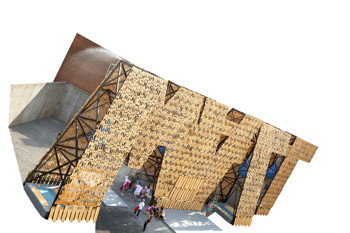THE ESSENTIALS
The Essentials
ESSENTIALLY NYCAlumni, staff help rebuild town hit by
Hurricane Sandy

Alumni assist in cleanup at Breezy Point, Queens. Photo: Tom Fox. See larger image
In October 2012, Hurricane Sandy directed special wrath on Breezy Point, Queens, N.Y., destroying more than 400 homes. On June 15, 65 Cornellians pitched in to remove debris, build houses and create planters for recently returned senior citizens and veterans.
The group, including alumni, 4-H members and staff from Cornell University Cooperative Extension-NYC (CUCE-NYC) and the Cornell Office of Alumni Affairs-Metro NY, demolished tiles, shoveled sand, installed sheet rock, painted and planted window boxes.

Alumni assist in cleanup at Breezy Point, Queens. Photo: Tom Fox. See larger image
"Although the devastation is at times overwhelming for all of us who live here, this is a resilient community, and we continue to find feasible ways to aid in the recovery from the destruction and related challenges," said Breezy Point resident Gretchen Ferenz, a CUCE-NYC senior extension associate. "We have been fortunate to have many volunteers lending their support."
Added Jim Killoran, director of Habitat for Humanity of Westchester County who has been spearheading home rebuilding on Breezy Point: "Cornell's efforts exemplified how service can help be a real solution to a disaster recovery."
CUCE-NYC plans another service event this fall when Cornell volunteers will distribute and plant 300 trees.
'Party Wall' at MoMA
Kids at Party Wall installation. Photo: Zachary Newton. See larger image
"Party Wall," a Trojan horse-sized installation designed by assistant professor of architecture Caroline O'Donnell, eclipsed 30 nominees to win the MoMA PS1 2013 Young Architects Program earlier this year. The annual contest is designed to engage young, innovative architects in creating a temporary structure for installation in the courtyard of PS1 in Long Island City, not far from the planned Roosevelt Island site of the Cornell Tech campus.

Detail of Party Wall installation. Photo: Zachary Newton. See larger image
O'Donnell (pictured above, center, shaking hands), who holds the Richard Meier Professorship of Architecture, designed "Party Wall" with her team at CODA, an Ithaca-based architecture firm.
"If you want to know what the Faculty Renewal initiative is doing for the university," said Kent Kleinman, dean of the College of Architecture, Art and Planning, at the Party Wall's alumni event on July 9, "Caroline O'Donnell is a shining example of creativity, ingenuity and the future of Cornell."

Caroline O'Donnell greets visitors to Party Wall installation. See larger image
It was open to the public from June 27-Aug. 31; the July event attracted more than 500 attendees.
"Every year, a canopy appears, something familiar appears, and then something unbelievable appears – such as this," said Berry Bergdoll, chief curator of architecture and design at MoMA.
Composed of remaindered steel and wood recycled from skateboard manufacture, and ballasted by hot air balloon-sized bladders of water, "Party Wall" not only met the demands of the contest – combining shade, seating and water with sustainability in mind – it also incorporated elements of the urban landscape.
A group of Cornell undergraduates, graduate students and first-year teaching associates were among those who assisted with the project. During "Skateboard Saturdays" in Ithaca, they created the 150 panels used to build the structure.
Pannell caps epic career with Tewaaraton Trophy

Tewaaraton Trophy logo. Credit: Tewaartan Award Foundation. See larger image

Rob Pannell. Photo: Athletic Communications. See larger image
Rob Pannell was named the winner of the 2013 Tewaaraton Trophy, the premier award in collegiate lacrosse, in a ceremony held in May at the Smithsonian Institution's National Museum of the American Indian in Washington, D.C. He is the Big Red's second recipient of the award, joining Max Seibald '09.
He is the first-ever three-time Ivy League Player of the Year in men's lacrosse and just the fourth player in the history of Division I college lacrosse to be named conference player of the year three times.
The all-time NCAA Division I career points leader (354), Pannell became one of just four Cornell players to earn All-American honors four times during his career.

Rob Pannell on the field. Photo: Athletic Communications. See larger image
Pannell finished the 2013 campaign with 102 points, just three off the school record, and the most ever for a Tewaaraton Award winner. His 47 goals rank 10th best in a single season.
Pannell began his rookie season this spring with Major League Lacrosse's New York Lizards, was named to the MLL All-Star team, and was named rookie of the year in August. Other Cornellians on the Lizards are Seibald, Max Van Bourgondien '13, Steve Mock '13 and Thomas Keith '13.
Moog archives come to library

Robert Moog, Ph.D. '65. Credit: Moog Music Inc. See larger image
The notes, plans, drawings and recordings of Robert Moog, Ph.D. '65, inventor of his namesake synthesizer, have found a home at Cornell University Library thanks to a donation from his widow, Ileana Grams-Moog. The Moog archive will be housed in the library's Division of Rare and Manuscript Collections.
"It was Bob's wish that his archives be preserved and made accessible to other scientists, inventors, engineers and innovators," Grams-Moog said. "The Cornell Library makes its extensive rare collections accessible to students and scholars all over the world. It has been eight years since my husband's death, and I am happy that my gift to Cornell will finally make this rich collection available."
Alum finds Neptune's new moon
Astronomer Mark Showalter, M.S. '83, Ph.D. '85, principal investigator at the Carl Sagan Center for the Study of Life in the Universe, has discovered Neptune's 14th and smallest known moon – catchily called S/2004 N 1 – while studying segments of rings around Neptune. The 12-mile-diameter moon revolves around Neptune once every 23 hours.

Diagram of orbits of Neptune's moons. Credit: NASA, ESA, M. Showalter/SETI Institute. See larger image
According to NASA, the moon is roughly 100 million times dimmer than the faintest star visible to the naked eye, and so small that the Voyager spacecraft failed to spot it in 1989 when it passed close by Neptune and surveyed the planet's moons and rings.
Showalter tracked the movement of a white fleck appearing over and over again in more than 150 photographs of Neptune by the Hubble telescope between 2004 and 2009. "The moons and arcs orbit very quickly, so we had to devise a way to follow their motion to bring out the details of the system," Showalter said. "It's the same reason a sports photographer tracks a running athlete - the athlete stays in focus, but the background blurs."
Showalter's Ph.D. adviser, Joe Burns, professor of mechanical and aerospace engineering, said: "This adds to his discoveries of two moons of Uranus, two about Pluto and another around Saturn, and his sightings of two faint rings at Uranus and one at Jupiter. Visits to the outer solar system by spacecraft have been coupled with the clever use of image-enhancement of telescopic data to account for most of Mark's discoveries ... Mark's latest discovery pushes these models forward by adding one more piece to the puzzle."